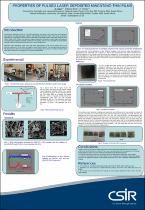JavaScript is disabled for your browser. Some features of this site may not work without it.
- ResearchSpace
- →
- Research Publications/Outputs
- →
- Conference Publications
- →
- View Item
| dc.contributor.author |
Yalisi, B

|
|
| dc.contributor.author |
Roro, Kittessa T

|
|
| dc.contributor.author |
Forbes, A

|
|
| dc.date.accessioned | 2012-01-10T09:22:49Z | |
| dc.date.available | 2012-01-10T09:22:49Z | |
| dc.date.issued | 2011-05 | |
| dc.identifier.citation | Yalisi, B, Roro, K.T. and Forbes, A. 2011. Properties of pulsed laser deposited NiO/MWCNT thin films. 11th International Conference on Frontiers of Polymers and Advanced Materials (ICFPAM2011), University of Pretoria, Pretoria, 22 - 27 May 2011 | en_US |
| dc.identifier.uri | http://hdl.handle.net/10204/5460 | |
| dc.description | 11th International Conference on Frontiers of Polymers and Advanced Materials (ICFPAM2011), University of Pretoria, Pretoria, 22 - 27 May 2011 | en_US |
| dc.description.abstract | Pulsed laser deposition (PLD) is a thin-film deposition technique, which uses short and intensive laser pulses to evaporate target material. The technique has been used in this work to produce selective solar absorber (SSA) thin film composites of multiwall carbon nanotubes (MWCNT) and nickel oxide (NiO). Whilst most physical vapour deposition techniques require high temperatures to achieve good adhesion between substrate and coating, with PLD it is possible to get excellent adhesionwith the substrate temperature set at room temperature. Selective solar absorbers must have high solar absorptance in the UV-Vis region and a low thermal emittance in the far infra red region to avoid thermal losses. The strength and durability of the thin films are also of critical importance if the coating is to be used in the field, therefore tests have been carried out on samples in the work presented here. It is concluded that: (1) MWCNT/NiOcomposite thin films have been successfully fabricated with the PLD technique, (2) SEM has confirmed that the MWCNT have been decorated with NiO nanoparticles and Raman confirms the formation of a new material with different vibrational properties, (3) the solar absorptance starts by increasing, gets constant before starting to reduce again, and (4) it has been found that the thin films adhere to the substrate and that the accelerated ageing tests has no significant impact on the optical properties of the thin composite material thin film coating. | en_US |
| dc.language.iso | en | en_US |
| dc.publisher | ICFPAM2011 | en_US |
| dc.relation.ispartofseries | Workflow request;7696 | |
| dc.subject | Pulsed laser deposition | en_US |
| dc.subject | Selective solar absorbers | en_US |
| dc.subject | Thin films | en_US |
| dc.subject | Polymers | en_US |
| dc.subject | Advanced materials | en_US |
| dc.subject | ICFPAM2011 | en_US |
| dc.title | Properties of pulsed laser deposited NiO/MWCNT thin films | en_US |
| dc.type | Conference Presentation | en_US |
| dc.identifier.apacitation | Yalisi, B., Roro, K. T., & Forbes, A. (2011). Properties of pulsed laser deposited NiO/MWCNT thin films. ICFPAM2011. http://hdl.handle.net/10204/5460 | en_ZA |
| dc.identifier.chicagocitation | Yalisi, B, Kittessa T Roro, and A Forbes. "Properties of pulsed laser deposited NiO/MWCNT thin films." (2011): http://hdl.handle.net/10204/5460 | en_ZA |
| dc.identifier.vancouvercitation | Yalisi B, Roro KT, Forbes A, Properties of pulsed laser deposited NiO/MWCNT thin films; ICFPAM2011; 2011. http://hdl.handle.net/10204/5460 . | en_ZA |
| dc.identifier.ris | TY - Conference Presentation AU - Yalisi, B AU - Roro, Kittessa T AU - Forbes, A AB - Pulsed laser deposition (PLD) is a thin-film deposition technique, which uses short and intensive laser pulses to evaporate target material. The technique has been used in this work to produce selective solar absorber (SSA) thin film composites of multiwall carbon nanotubes (MWCNT) and nickel oxide (NiO). Whilst most physical vapour deposition techniques require high temperatures to achieve good adhesion between substrate and coating, with PLD it is possible to get excellent adhesionwith the substrate temperature set at room temperature. Selective solar absorbers must have high solar absorptance in the UV-Vis region and a low thermal emittance in the far infra red region to avoid thermal losses. The strength and durability of the thin films are also of critical importance if the coating is to be used in the field, therefore tests have been carried out on samples in the work presented here. It is concluded that: (1) MWCNT/NiOcomposite thin films have been successfully fabricated with the PLD technique, (2) SEM has confirmed that the MWCNT have been decorated with NiO nanoparticles and Raman confirms the formation of a new material with different vibrational properties, (3) the solar absorptance starts by increasing, gets constant before starting to reduce again, and (4) it has been found that the thin films adhere to the substrate and that the accelerated ageing tests has no significant impact on the optical properties of the thin composite material thin film coating. DA - 2011-05 DB - ResearchSpace DP - CSIR KW - Pulsed laser deposition KW - Selective solar absorbers KW - Thin films KW - Polymers KW - Advanced materials KW - ICFPAM2011 LK - https://researchspace.csir.co.za PY - 2011 T1 - Properties of pulsed laser deposited NiO/MWCNT thin films TI - Properties of pulsed laser deposited NiO/MWCNT thin films UR - http://hdl.handle.net/10204/5460 ER - | en_ZA |






